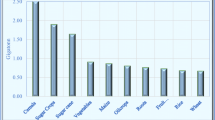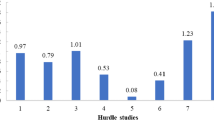Abstract
Heating of sugarcane juice gives concentrated sugarcane juice (CSJ) which becomes raw material for the production of a variety of value added products. Conventional ways of CSJ production are environment polluting and indulge in huge amount of energy losses. In this study, an attempt is made to obtain final CSJ (98°B) by induction heating (IH) which is environment friendly and causes minimum energy losses. The experiments are performed at constant heat flux (9947.5 W m−2) on samples of sugarcane juice having 14.2°B, 18.8°B, 23.9°B, and 27.4°B values of initial brix contents. Thermo-enviro-economic analyses are carried out for the experiments conducted on given samples. The results concluded that time required for obtaining final CSJ decreases and evaporation rate increases with increase in initial brix value of sugarcane juice. The energy required for obtaining final CSJ from sugarcane juice of 27.4°B is 683.43 kJ which is 154.3% less as compared to that of fresh sugarcane juice heating with 14.2°B. The environmental parameters have no discernible effects of initial brix value while economic factors were improved. IH is observed thermally and environmentally beneficial with lower costs of CSJ production from the juice of higher initial brix contents.



Similar content being viewed by others
Abbreviations
- Nu:
-
Nusselt number
- Pr:
-
Prandtl number for vapour
- Prl :
-
Prandtl number for liquid
- Gr:
-
Grashof number
- \({\mathcalligra{q}}\) :
-
Heat flux utilization rate (W m−2 s−1)
- HTC:
-
Heat transfer coefficient (W m−2 °C−1)
- Temp.:
-
Temperature (°C)
- h c,s :
-
Convective HTC for sensible heating, (W m−2 °C−1)
- h e,s :
-
Evaporative HTC for sensible heating, (W m−2 °C−1)
- \({U}_{\mathrm{s}}\) :
-
Overall heat transfer coefficient for sensible heating, (W m−2 °C−1)
- h c,p :
-
Convective HTC for pool boiling (W m−2 °C−1)
- h e,p :
-
Evaporative HTC for pool boiling (W m−2 °C−1)
- \({U}_{\mathrm{p}}\) :
-
Overall heat transfer coefficient for pool boiling (W m−2 °C−1)
- \(e\) :
-
Thickness of pot base (m)
- \(k\) :
-
Thermal conductivity of pot material (W m−1 °C−1)
- \({Q}_{\mathrm{s}}\) :
-
Actual heat transfer required during sensible heating (W)
- \({Q}_{\mathrm{p}}\) :
-
Actual heat transfer required during pool boiling (W)
- \({\mu }_{\mathrm{l}}\) :
-
Viscosity of liquid (kg m−1 s−1)
- \({\rho }_{\mathrm{l}}\) :
-
Density of saturated liquid (kg m−3)
- \({h}_{\mathrm{fg}}\) :
-
Enthalpy of vaporization (J kg−1)
- \({T}_{\mathrm{a}}\) :
-
Ambient temp. (°C)
- \({T}_{\mathrm{j}}\) :
-
Juice temp. (°C)
- \({T}_{\mathrm{js}}\) :
-
Temp. of juice surface (°C)
- \({T}_{\mathrm{s}}\) :
-
Temp. pot bottom surface (°C)
- \({T}_{\mathrm{sw}}\) :
-
Temp. of side wall (°C)
- \({T}_{\mathrm{sat}}\) :
-
Saturation temp. of sugarcane juice (°C)
- \({T}_{\mathrm{v}}\) :
-
Vapor temp. (°C)
- \({U}_{\mathrm{b}}\) :
-
Overall heat transfer coefficient for pool boiling of sugarcane juice
- m e :
-
Mass of water evaporated (g)
- γ :
-
Relative humidity (%)
- X c :
-
Space between juice surface and glass cover (m)
- K v :
-
Thermal conductivity (W m−1 °C−1)
- λ :
-
Latent heat (J kg−1)
- λ evp :
-
Latent heat of evaporation = 2430 kJ kg−1
- t :
-
Time (s)
- A :
-
Area of basin (m2)
- \(\dot{r}\) :
-
Evaporation rate (g min−1)
- \(\sigma\) :
-
Surface tension of sugarcane juice (W m−1)
- \({q}_{\mathrm{nucleate}}\) :
-
Nucleate boiling heat flux (W m−2)
- OIHS:
-
Open induction heating system
- NCS:
-
Non-centrifugal sugar
- SERS:
-
Sustainable energy recovery system
- CSJ:
-
Concentrated sugarcane juice
- C, \({C}_{\mathrm{sf}}\), n :
-
Experimental constants
- °B:
-
Brix contents
References
Anwar SI. Improving thermal efficiency of open pan jaggery furnaces—a novel concept. Indian J Sugarcane Technol. 2014;29:32–4.
Kumar R, Kumar M. Upgradation of jaggery production and preservation technologies. Renew Sustain Energy Rev. 2018;96:167–80. https://doi.org/10.1016/j.rser.2018.07.053.
Anwar SI. Fuel and energy saving in open pan furnace used in jaggery making through modified juice boiling/concentrating pans. Energy Convers Manag. 2010;51:360–4. https://doi.org/10.1016/j.enconman.2009.09.033.
Kumar R, Kumar M. Performance evaluation of a modified jaggery making plant: a comparative study. J Food Process Eng. 2021;44:e13712. https://doi.org/10.1111/jfpe.13712.
Kumar R, Kumar M. Thermoeconomic analysis of a modified jaggery making plant. Heat Transf. 2021;50:4871–91. https://doi.org/10.1002/htj.22107.
Tyagi SK, Kamboj S, Himanshu, Tyagi N, Narayanan R, Tyagi VV. Technological advancements in jaggery-making processes and emission reduction potential via clean combustion for sustainable jaggery production: an overview. J Environ Manag. 2022;301:113792. https://doi.org/10.1016/J.JENVMAN.2021.113792.
Tyagi SK, Tyagi N, Himanshu H, Kamboj S, Agarwal KK, Sharma U, Tyagi VV. Emission reduction and fuel-saving potentials in jaggery industry via cleaner combustion. Int J Ambient Energy. 2021;43:4728–43. https://doi.org/10.1080/01430750.2021.1914726.
Tiwari GN, Kumar S, Prakash O. Study of heat and mass transfer from sugarcane juice for evaporation. Desalination. 2003;159:81–96. https://doi.org/10.1016/S0011-9164(03)90047-6.
Kumar M, Kasana KS, Kumar S, Prakash O. Energy requirements in manufacture of khoa under closed condition. Int J Mech Eng Res Dev. 2011;1:33–40.
Kumar M, Prakash O, Kasana KS. An experimental study on pool boiling of milk. Heat Transf Res. 2011;40:159–70. https://doi.org/10.1002/htj.20336.
Tiwari GN, Prakash O, Kumar S. Evaluation of convective heat and mass transfer for pool boiling of sugarcane juice. Energy Convers Manag. 2004;45:171–9. https://doi.org/10.1016/S0196-8904(03)00143-2.
Marcelo D, Yacila PV, La Madrid Olivares R. Experimental analysis of the pool boiling phenomenon of sugarcane juice. Appl Mech Mater. 2015;789–790:489–95. https://doi.org/10.4028/www.scientific.net/amm.789-790.489.
Villar P, Marcelo D, Saavedra R, La Madrid R. An experimental study of heat transfer in pool boiling of sugarcane juice. JP J Heat Mass Transf. 2016;13:445–64. https://doi.org/10.17654/hm013040445.
Kumar M. Forced convection drying of Khoa: a heat desiccated milk product. J Eng Technol. 2014;4:110–4. https://doi.org/10.4103/0976-8580.141182.
Kumar M, Kumar S, Prakash O, Kasana K. Evaporative heat transfer coefficients during sensible heating of milk, SAMRIDDHI A. J Phys Sci Eng Technol. 2011;3:1–6.
Kumar M, Kasana K, Prakash O. Experimental study on heat and mass transfer for heating milk. J Energy S Afr. 2011;22:53.
Pioro IL. Experimental evaluation of constants for the Rohsenow pool boiling correlation. Int J Heat Mass Transf. 1999;42:2003–13. https://doi.org/10.1016/S0017-9310(98)00294-4.
Kumar M, Kumar S, Prakash O, Kasana KS. Pool boiling of milk in a stainless steel pot under closed condition. Int J Curr Res. 2011;3:94–9.
da Silva DR, Crespi MS, Ribeiro CA, Capela JMV. Thermal decomposition kinetics of sugarcane mills wastes. J Therm Anal Calorim. 2018;131:811–22. https://doi.org/10.1007/s10973-017-6270-z.
Kumar M, Prakash O, Kasana KS. Experimental investigation on natural convective heating of milk. J Food Process Eng. 2012;35:715–26. https://doi.org/10.1111/J.1745-4530.2010.00620.X.
Buchholz M, Lüttich T, Auracher H, Marquardt W. Experimental investigation of local processes in pool boiling along the entire boiling curve. Int J Heat Fluid Flow. 2004;25:243–61. https://doi.org/10.1016/j.ijheatfluidflow.2003.11.020.
Grewal R, Kumar M. An experimental study on solar evaporation of sugarcane juice. Heat Transf. 2021;50:8378–402. https://doi.org/10.1002/htj.22281.
Chaudhary R, Yadav A. Experimental investigation of solar cooking system based on evacuated tube solar collector for the preparation of concentrated sugarcane juice used in jaggery making. Environ Dev Sustain. 2021;23:647–63. https://doi.org/10.1007/s10668-020-00601-8.
Grewal R, Kumar M. Comparative study on stepped solar distillers internally loaded with different masses of phase change material. Int J Energy Res. 2022;46:12948–62. https://doi.org/10.1002/er.8071.
Grewal R, Kumar M. Investigations on effect of mass of phase change material on sugarcane juice concentration and distillate production in a stepped solar system. J Energy Storage. 2022;52:104878. https://doi.org/10.1016/j.est.2022.104878.
Grewal R, Kumar M. A comprehensive review on stepped solar still and induction heating applications. Mater Today Proc. 2022;56:2696–703. https://doi.org/10.1016/j.matpr.2021.09.376.
Rudnev V, Loveless D, Cook RL. Handbook of induction heating. 2nd ed. Boca Raton: CRC Press; 2017. https://doi.org/10.1201/9781315117485.
Lucía O, Maussion P, Dede E, Burdio J. Induction heating technology and its applications: past developments, current technology, and future challenges. IEEE Trans Ind Electron. 2013;61:2509–20.
Grewal R, Kumar M. Assessment of a solar powered sustainable energy recovery system for cleaner production of concentrated sugarcane juice. Sustain Energy Technol Assess. 2022;52:102271. https://doi.org/10.1016/j.seta.2022.102271.
Anwar SI, Tiwari GN. Evaluation of convective heat transfer coefficient in crop drying under open sun drying conditions. Energy Convers Manag. 2001;42:627–37. https://doi.org/10.1016/S0196-8904(00)00065-0.
Shimpy, Kumar M, Kumar A, Sahdev RK, Manchanda H. Comparison of groundnut drying in simple and modified natural convection greenhouse dryers: thermal, environmental and kinetic analyses. J Stored Prod Res. 2022;98:101990. https://doi.org/10.1016/j.jspr.2022.101990.
Shimpy, Kumar M, Sahdev RK, Manchanda H, Kumar A. Experimental investigations on latent heat storage based modified mixed-mode greenhouse groundnuts drying. J Food Process Preserv. 2022;46:e16725. https://doi.org/10.1111/jfpp.16725.
Malik MAS, Tiwari GN, Kumar A, Sodha MS. Solar distillation: a practical study of a wide range of stills and their optimum design, construction and performance, 1st edn. Oxford: Pergamon Press. 1982. https://www.osti.gov/etdeweb/biblio/6028832.
Kabeel AE, Abdelaziz GB, El-Said EMS. Experimental investigation of a solar still with composite material heat storage: energy, exergy and economic analysis. J Clean Prod. 2019;231:21–34. https://doi.org/10.1016/j.jclepro.2019.05.200.
Datt P. Latent heat of condensation. Encycl Earth Sci Ser. 2011;33:702–70. https://doi.org/10.1007/978-90-481-2642-2_326.
Thakur VK, Gaur MK. Study the effect of CuO nanoparticles on the performance of passive solar still in winter and summer season. Mater Today Proc. 2022;57:2009–17. https://doi.org/10.1016/j.matpr.2021.11.119.
Yousef MS, Hassan H. Assessment of different passive solar stills via exergoeconomic, exergoenvironmental, and exergoenviroeconomic approaches: a comparative study. Sol Energy. 2019;182:316–31. https://doi.org/10.1016/j.solener.2019.02.042.
Elbar A, Refat A, Hassan H. Energy, exergy and environmental assessment of solar still with solar panel enhanced by porous material and saline water preheating. J Clean Prod. 2020;277:124175. https://doi.org/10.1016/j.jclepro.2020.124175.
Bait O. Exergy, environ–economic and economic analyses of a tubular solar water heater assisted solar still. J Clean Prod. 2019;212:630–46. https://doi.org/10.1016/j.jclepro.2018.12.015.
Gaur MK, Thakur VK. Experimental analysis of sustainability of passive solar still with nanoparticles operating at various angles of glass cover. Energy Sources Part A Recover Util Environ Eff. 2022;44:5227–45. https://doi.org/10.1080/15567036.2022.2082600.
Singh K, Samsher A. Material conscious energy matrix and enviro-economic analysis of passive ETC solar still. Mater Today Proc. 2021;38:1–5. https://doi.org/10.1016/j.matpr.2020.05.117.
Author information
Authors and Affiliations
Contributions
RG contributed to Experimentation, data collection and analysis, writing—original draft preparation. MK contributed to Conceptualization, methodology, supervision, reviewing and editing.
Corresponding author
Additional information
Publisher's Note
Springer Nature remains neutral with regard to jurisdictional claims in published maps and institutional affiliations.
Appendices
Appendices
Appendix 1: Parameters used in thermal model for sensible heating
The various parameters used in thermal model for sensible heating are calculated by the below equations [8, 11].
Appendix 2: Parameters used in thermal model of heat transfer during pool boiling
The various parameters used in thermal model of heat transfer during pool boiling are evaluated by the below equations [8, 9, 11, 17].
\(\rho_{{\text{l}}}\) is density of juice at \(T_{{\text{j}}}\) and B is the brix content.
where, \(\rho_{{\text{v}}}\) is density of vapor at \(T_{{\text{i}}} = \frac{{T_{{\text{j}}} + T_{{\text{v}}} }}{2}\)
\(h_{{{\text{fg}}}}\) is enthalpy of vaporization, \(c_{{\text{p}}}\) is specific heat capacity of vapor and \(X_{{\text{w}}}\) is mass of evaporated water content.
Thermal conductivity (\(k_{{\text{l}}}\)), specific heat (\(c_{{{\text{pl}}}}\)), viscosity (\(\mu_{{\text{l}}}\)) of sugarcane juice are evaluated as
Appendix 3: Environmental analysis of the system [31, 32, 37,38,39,40,41].
where Mx is mass of the material in kg and CEem is embodied energy coefficient in kWh kg−1
where, \(\lambda\) is the latent heat of vapourization (i.e., \(\lambda\) = 2.43 × 106 J kg−1).
\(S_{{{\text{days}}}}\) are the operating days for system which is taken as 290 days
where \(a\) is the lifespan of the designed system taken as 30 years.
In Eq. (50), the cost of carbon credit (\({\text{C}}_{{{\text{CCE}}}}\)) is taken as $15.
Rights and permissions
Springer Nature or its licensor (e.g. a society or other partner) holds exclusive rights to this article under a publishing agreement with the author(s) or other rightsholder(s); author self-archiving of the accepted manuscript version of this article is solely governed by the terms of such publishing agreement and applicable law.
About this article
Cite this article
Grewal, R., Kumar, M. Induction heating of sugarcane juice: thermo-enviro-economic analyses. J Therm Anal Calorim 148, 7939–7950 (2023). https://doi.org/10.1007/s10973-023-12268-0
Received:
Accepted:
Published:
Issue Date:
DOI: https://doi.org/10.1007/s10973-023-12268-0




